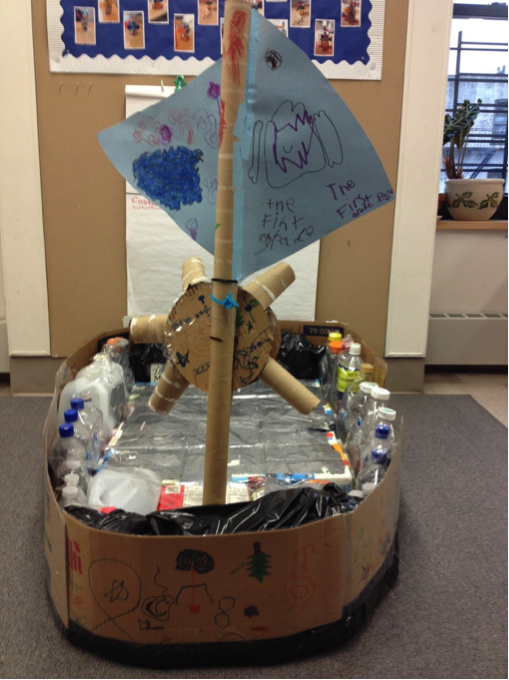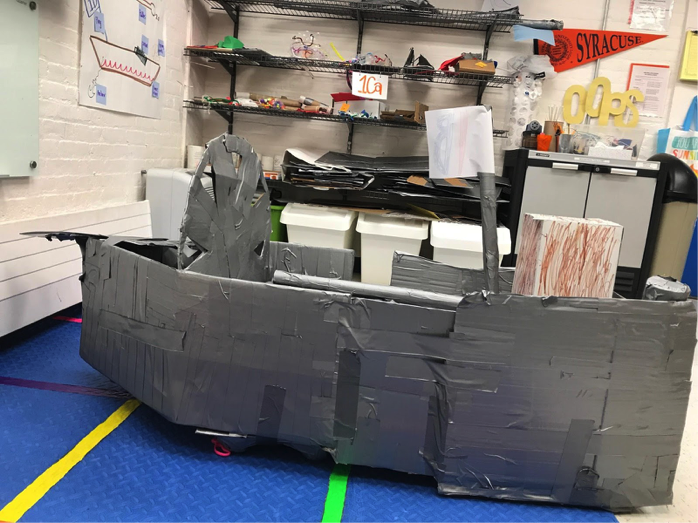STEAM Study in the Classroom – The First Grade Boat Project
by Camille Harrison
It all started with a question.
Our science teacher was discussing her unit on buoyancy. She wanted some help figuring out what other materials students could use to build small boats that would float in small kiddie pools in her classroom. She also just happened to witness a cardboard boat regatta in her hometown on Long Island, NY and had the sliver of an idea—“What if first graders made a boat that would be big enough to float one of them in our school’s pool?”
When she talked to me about this idea we quickly decided it wouldn’t work to put a student in a boat we weren’t sure would float, especially as they are still learning to swim. But how about a teacher? As someone who tends to say yes before fully thinking through things I agreed enthusiastically only to then worry what this actually meant. And so an idea was born.
In social studies, first grade students learn about waste and recycling. Through a variety of activities students develop a deep sense of why it’s so important to reduce our use and recycle. The science teacher already did some activities connected to this study, so it seemed like a natural connection to challenge our students (and ourselves) to building a boat using materials we would normally recycle.
The first year we did this project we had students build the boat using clear packing tape, and milk cartons. We asked families to bring in any cartons they had, which with three classes of students collecting (roughly 60 students) we had more than enough to build our first boat. For our students, the main goal was to challenge them to apply what they had learned about buoyancy and general boat design. For ourselves, the challenge was managing so many student ideas into one final design.

The first ever First Grade Boat created in 2014 using milk cartons, plastic juice bottles and attached with clear packing tapes. Students were able to design different “accessories” to bring their boat to life.
Success! That first year with the help of one last design addition–a trash can at the bottom of the boat to cover any holes–the boat stayed afloat. That was our first attempt at this project four years ago. What started as a idea between colleagues is now a tradition for first grade students.

Going forward we decided to challenge ourselves and students by building not one boat, but three so that each class would have their own boat to design and build. Our students also recognized that as a school the big cardboard boxes that snack came in each week was highly wasteful. And so we added another element to this project–could students figure out a way to make cardboard repel water? Tape to the rescue again.


If you’re considering a large STEAM study in your classroom, consider partnering with a science teacher if you school has one. If not, I found partnering with at least one other teacher to bounce ideas off of and also help manage a larger project is invaluable. Also be prepared to celebrate failures with students. I can’t even begin to tell you how many cardboard boat prototypes just completely sunk as students tried to figure out the best way to wrap the cardboard, and what tape would hold up best. If you show students that failing is part of the process by making a public display of your own failures, you will encourage them to take risks and deepen their own learning.
Did any of the individual boats sink? Did the children want to built a new one?
This is a neatidea!
This was a very good idea to help children use their imagination.
I love using the snk or float projet. Children have to collect data about how boats float as well as hoe to onstruct a boat that will not sink. I think that this project can be modified to use in early childhood prorams by using rubber ducks, pennies, and other object that sink or float.
Awesome lesson